

In a capitalist economy, like that of the United States, some level of income inequality is to be expected. In recent years, however, the increasing consolidation of wealth in the hands of a few has gone beyond what many Americans deem to be justified or morally acceptable.
According to a recent report published by the New York-based financial firm JPMorgan Chase, the wealthiest 10% of American households control nearly 75% of household net worth. While no single factor is causing the growth in income inequality, trends like stagnant middle class wages and skyrocketing executive compensation certainly contribute. There are currently over a dozen major publicly traded companies where CEOs make 1,000 more than their typical employee.
While statistics like these help illustrate the problems associated with income inequality, for many Americans the phenomenon is largely conceptual as housing market prices and other forces tend to divide cities and neighborhoods by socioeconomic status. There are parts of the country, however, where the rich and poor live side by side. In these places, income inequality is a palpable and defining feature of daily life.
24/7 Wall St. reviewed the Gini coefficient — a standard measure for the distribution of wealth in an area — for over 3,000 U.S. counties and county equivalents to identify the 25 counties with the widest income gaps.
The counties and county equivalents on this list are concentrated in the South — but also dot the Northeast and western United States. They include both urban and rural counties, and more often than not, income inequality is driven largely by a concentration of poor residents (all but two counties on this list have a higher poverty than the 14.6% national poverty rate) rather than a concentration of extremely wealthy households. Still, many of these same counties fall within the limits of the 25 richest cities in America.

25. Winston County, Mississippi
> Population: 18,242
> Median household income: $33,313
> Households earning less than $10,000: 12.2%
> Households earning $200,000 or more: 3.0%
Winston County is located in north central Mississippi. The county seat is Louisville. An estimated 3.0% of households in the county earn $200,000 or more per year, a higher share than the 2.4% share of Mississippi households. The area’s high earning households are in close proximity to those facing serious financial hardship. More than one in every four Winston County residents live below the poverty line, and 23.9% of the population rely on SNAP benefits to afford groceries.

24. Radford, Virginia
> Population: 17,659
> Median household income: $36,082
> Households earning less than $10,000: 17.8%
> Households earning $200,000 or more: 2.0%
The income gap in Radford, an independent city in southern Virginia, is due in large part to the concentration of extremely poor households. Half of all households in Radford earn more than $36,000 a year, a far lower median income than the median nationwide of $57,652. Additionally, nearly 18% of Radford households earn less than $10,000 a year, more than double the 6.7% share of households nationwide with similarly low incomes.
College towns tend to have high income inequality on paper as many off-campus college students have little to no income, and Radford is home to Radford University, a major public university.

23. Glacier County, Montana
> Population: 13,675
> Median household income: $29,201
> Households earning less than $10,000: 17.3%
> Households earning $200,000 or more: 2.2%
Glacier County, located in northwestern Montana along the Canadian border, has a poverty rate of 33.1%, more than double the national poverty rate of 14.6%. Areas where a similarly large share of the population struggles financially often have few if any wealthy residents. In Glacier County, however, 2.2% of households earn at least $200,000 a year. Based on measures of economic mobility, Glacier also ranks among the counties where the American dream is dead.
Native American Indian reservations typically have far worse than typical economic conditions, and Glacier County encompasses much of the Blackfeet Indian Reservation.

22. Fulton County, Georgia
> Population: 1.0 million
> Median household income: $61,336
> Households earning less than $10,000: 7.7%
> Households earning $200,000 or more: 11.8%
Atlanta is the county seat of Fulton, the most populous county in Georgia. Like some other densely populated urban counties, income inequality is a conspicuous problem in Fulton County. Of all households in the area, 7.7% earn less than $10,000 a year, a larger share than the 6.7% of households nationwide. Meanwhile, 11.8% of households in the county earn at least $200,000 a year, nearly double the 6.3% share of households nationwide.
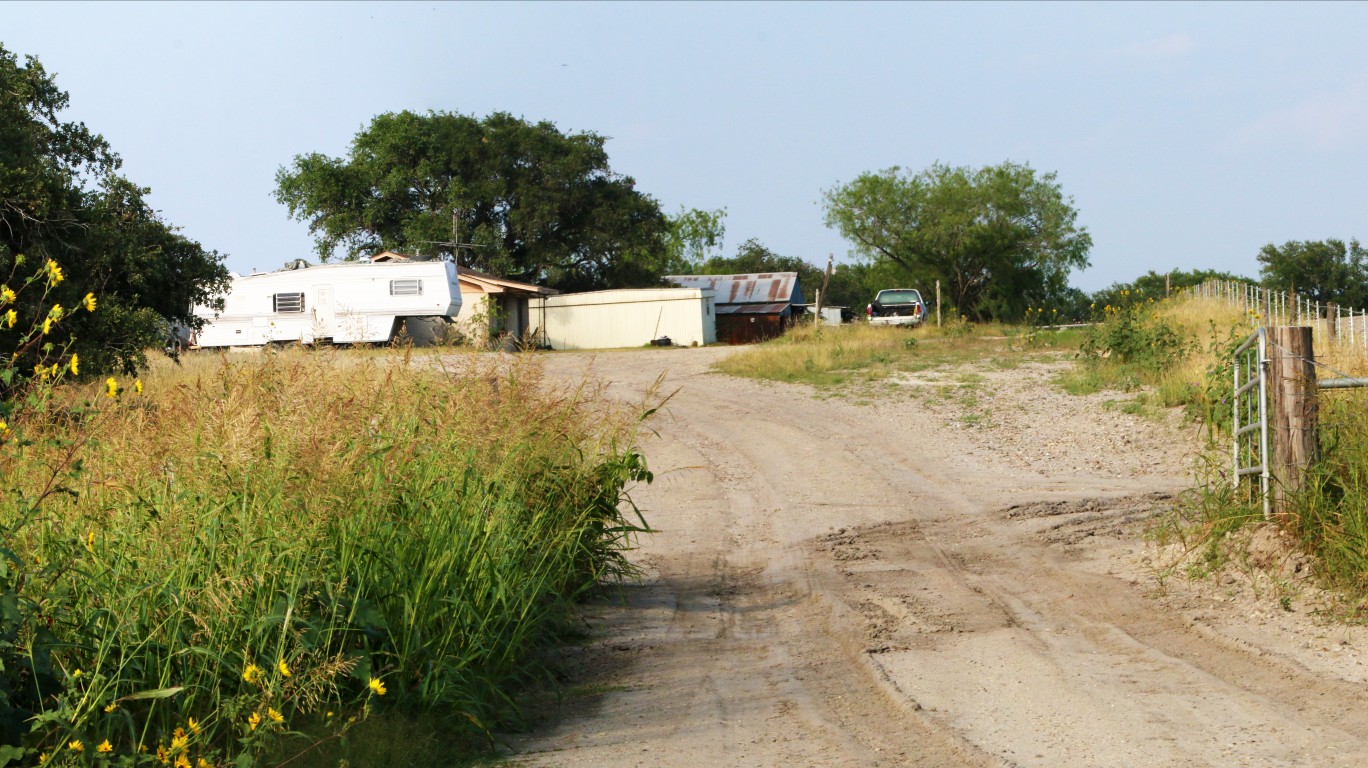
21. Karnes County, Texas
> Population: 15,516
> Median household income: $53,051
> Households earning less than $10,000: 9.4%
> Households earning $200,000 or more: 6.4%
Karnes is a small Texas County of about 15,500 people southeast of San Antonio. Most area households earn at least $53,000 a year, slightly below the national median income of $57,652. However, Karnes County is home to a far larger than typical share of residents facing serious financial hardship. Nearly one in every 10 households in Karnes County earns less than $10,000 a year compared to 6.7% of households nationwide.

20. Richmond, Virginia
> Population: 226,968
> Median household income: $42,356
> Households earning less than $10,000: 12.3%
> Households earning $200,000 or more: 5.2%
Richmond, the Virginia state capital, is an independent city that does not fall within the jurisdiction of a county. Financial hardship is relatively common in the city as 12.3% of households earn less than $10,000 a year, nearly double the 6.7% national share. Meanwhile, slightly more than 5% of households in the city earn $200,000 or more a year.
As is often the case, many of the higher earners in Richmond are college educated. The typical city resident 25 or older with only a high school diploma earns just $23,506 a year — 54% of the median annual earnings of $43,255 of the typical four-year college graduate.
[in-text-ad]
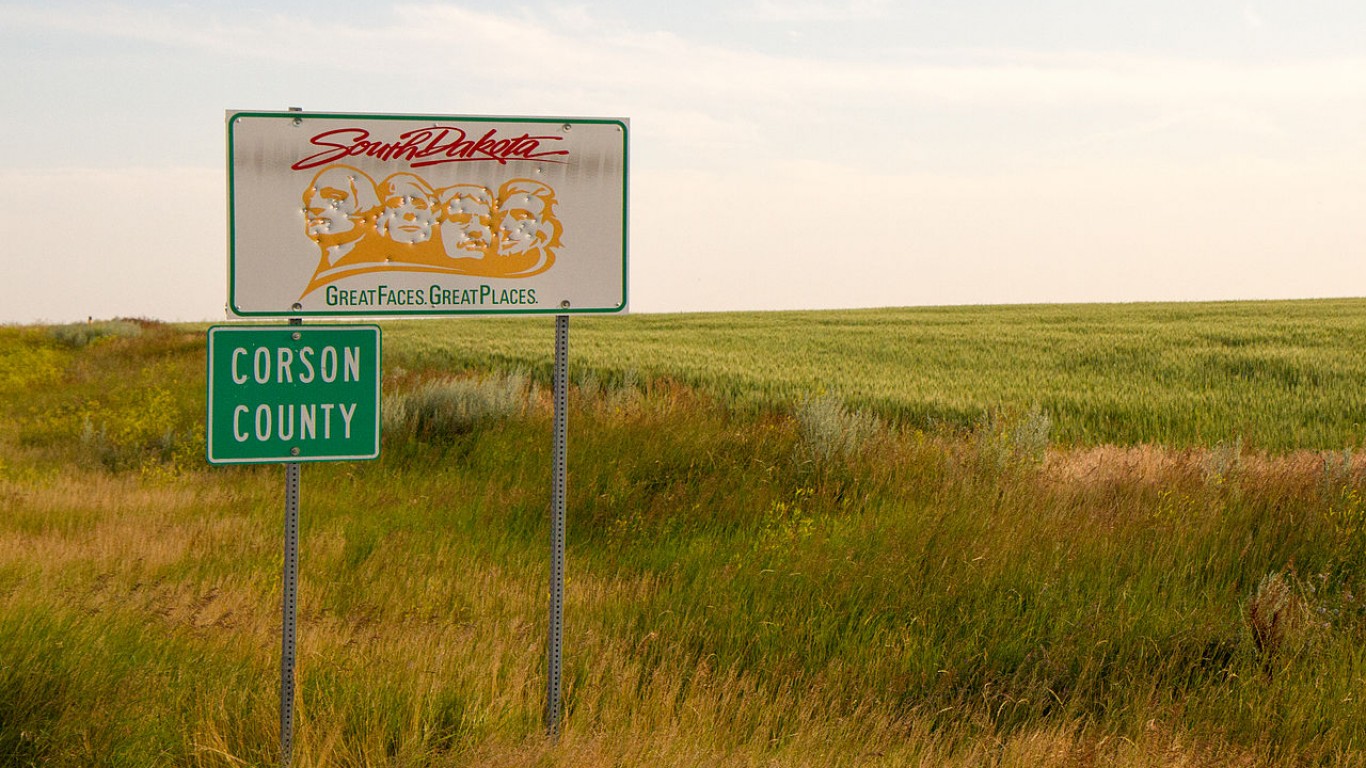
19. Corson County, South Dakota
> Population: 4,207
> Median household income: $32,260
> Households earning less than $10,000: 16.8%
> Households earning $200,000 or more: 2.4%
Corson County, which covers much of the Standing Rock Indian Reservation in northern South Dakota, is one of the poorest counties in the United States. Nearly half of all area residents — 47.9% — live below the poverty line, more than triple the 14.6% national poverty rate. Similarly poor areas nationwide often have nearly no high income residents. Corson County is an exception, however, as 2.4% of county households earn $200,000 or more per year.
Incomes tend to rise with educational attainment, and the poverty rate among area adults who did not finish high school is 61.6% — over four times the 13.7% poverty rate among adult college graduates.
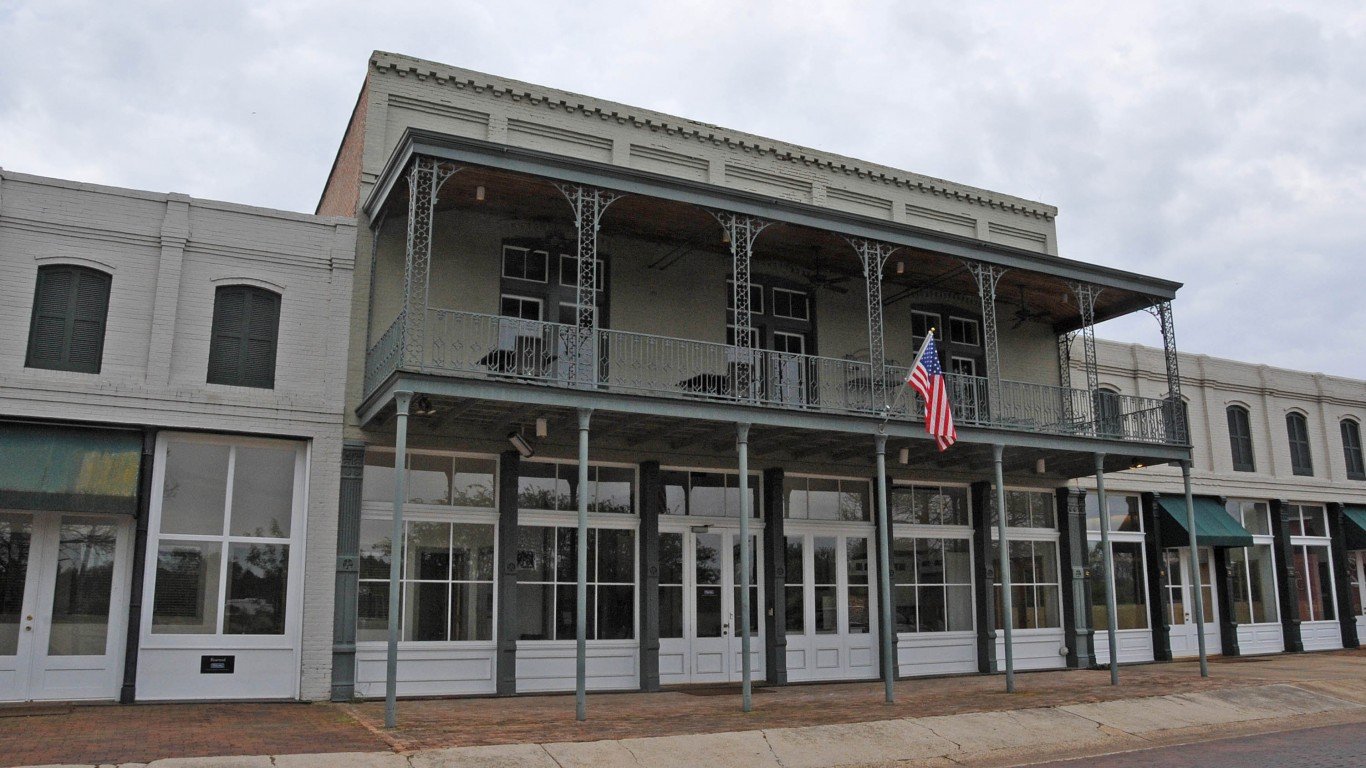
18. Leflore County, Mississippi
> Population: 29,324
> Median household income: $25,210
> Households earning less than $10,000: 24.4%
> Households earning $200,000 or more: 0.8%
Leflore County, Mississippi, is located about 100 miles north of the state capital of Jackson. The high degree of income inequality in Leflore County is not attributable to small pockets of wealth alongside small pockets of poverty, but rather to widespread poverty alongside more modest incomes. Nearly one in every four households in the county earn less than $10,000 a year, nearly the largest share of any U.S. county or county equivalent. Meanwhile, half of all households in the county earn at least $25,000 annually.
Due in large part to widespread financial hardship, Leflore ranks among the worst counties to live in.

17. Lincoln Parish, Louisiana
> Population: 47,465
> Median household income: $34,424
> Households earning less than $10,000: 18.6%
> Households earning $200,000 or more: 4.3%
Both extreme wealth and extreme poverty are more heavily concentrated in Lincoln Parish than they are across Louisiana as a whole. An estimated 18.6% of area households earn less than $10,000 a year, compared to 10.0% of households across the state as a whole. Meanwhile, 4.3% of households in the parish earn at least $200,000 a year compared to 4.0% of households across the state.
Income inequality tends to be intensified in areas around colleges and universities, and Lincoln Parish is home to Louisiana Tech University, a school with nearly 11,000 undergraduates. Also due in part to the University, Lincoln Parish ranks as the youngest county in Louisiana.
[in-text-ad-2]
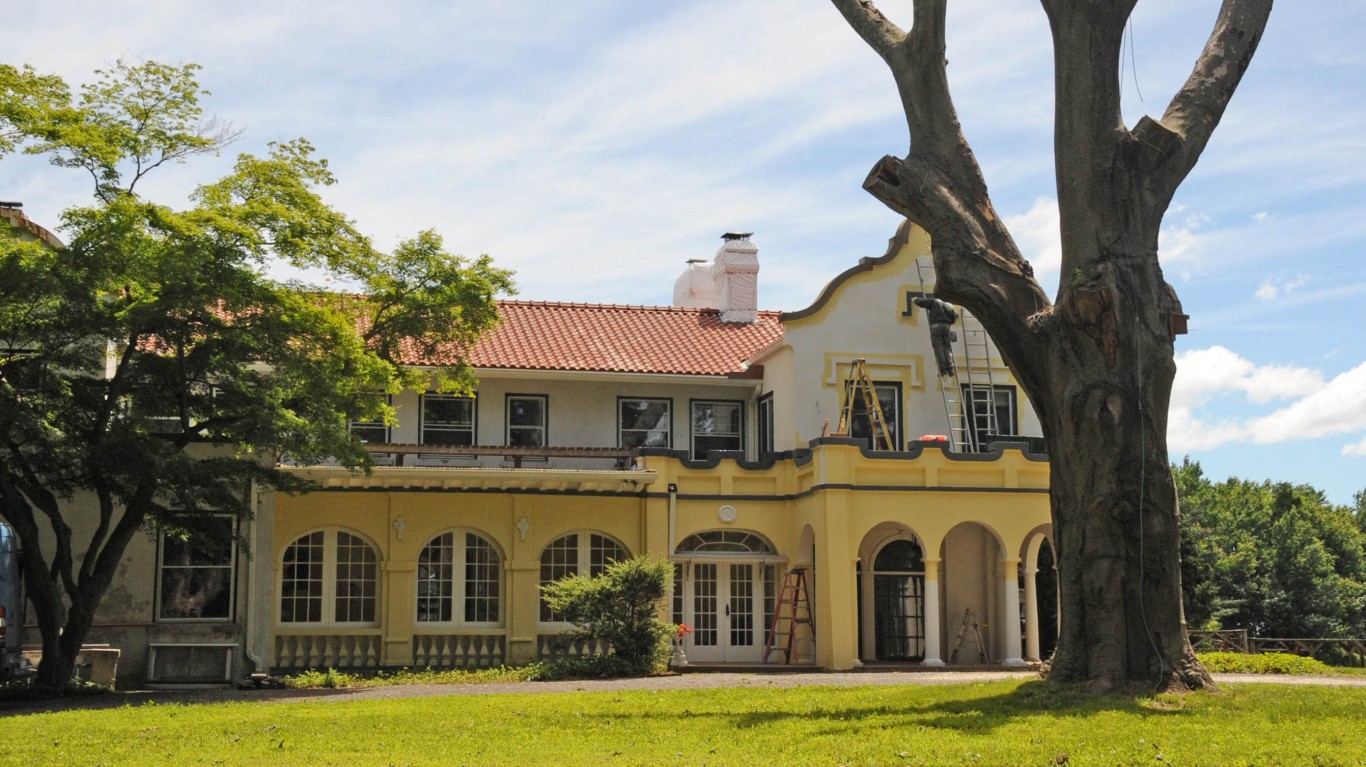
16. Fairfield County, Connecticut
> Population: 943,457
> Median household income: $89,773
> Households earning less than $10,000: 4.6%
> Households earning $200,000 or more: 19.7%
Fairfield County, a densely populated region in southwestern Connecticut, is the wealthiest county in the state and one of the wealthiest in the country. About 20% of area households earn at least $200,000 a year, more than triple the 6.3% of households earning as much nationwide. Fairfield also has a larger share of poor residents than is typical in similarly wealthy areas. Nearly 5% of Fairfield households earn less than $10,000 a year, and nearly one in every 10 area residents rely on SNAP benefits to afford groceries.
Those with a four-year college education are far more likely to earn high incomes in Fairfield County. The typical area adult with a bachelor’s degree earns $71,731 a year, more than double the median earnings of the typical adult with just a high school diploma of $31,832.

15. Caldwell Parish, Louisiana
> Population: 9,947
> Median household income: $31,933
> Households earning less than $10,000: 16.3%
> Households earning $200,000 or more: 1.4%
Caldwell Parish is a small area of less than 10,000 residents in north-central Louisiana. The high income inequality in the area is largely attributable to a concentration of extremely low-income residents and households. More than one in every four Caldwell Parish residents live below the poverty line, and 16.3% of households earn less than $10,000 a year. Meanwhile, about half of all households in Caldwell Parish earn at least $32,000 a year — a relatively low income but considerably greater than the extreme poverty wages.
[in-text-ad]
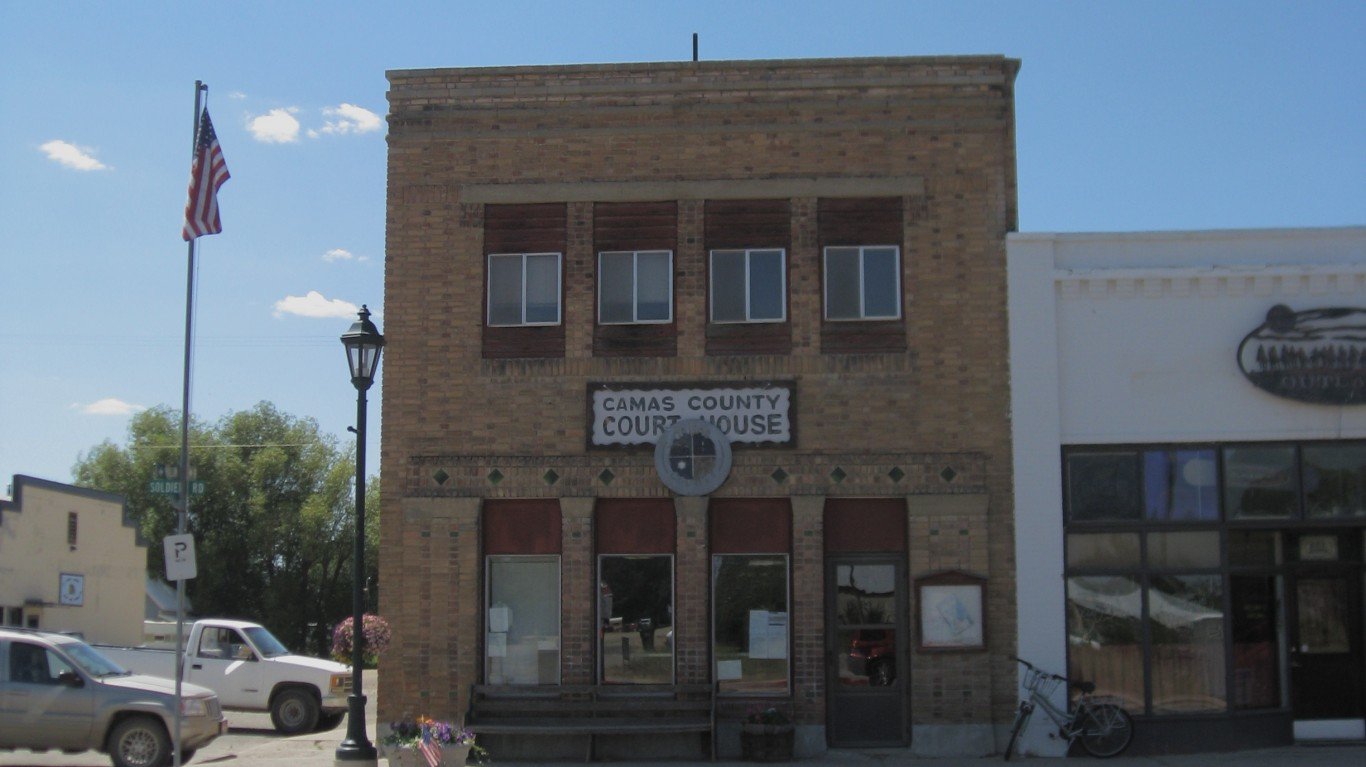
14. Camas County, Idaho
> Population: 1,097
> Median household income: $36,667
> Households earning less than $10,000: 5.7%
> Households earning $200,000 or more: 9.2%
Camas is a small central-Idaho county of only about 1,000 people. Over the last five years, the median annual household income in the area dipped by nearly $4,000 — and income inequality spiked more than in any other U.S. county or county equivalent. Currently, 9.2% of area households earn $200,000 or more per year, well above the 6.3% of households nationwide. At the same time, the county’s 22.3% poverty rate is well above the 14.6% national poverty rate.
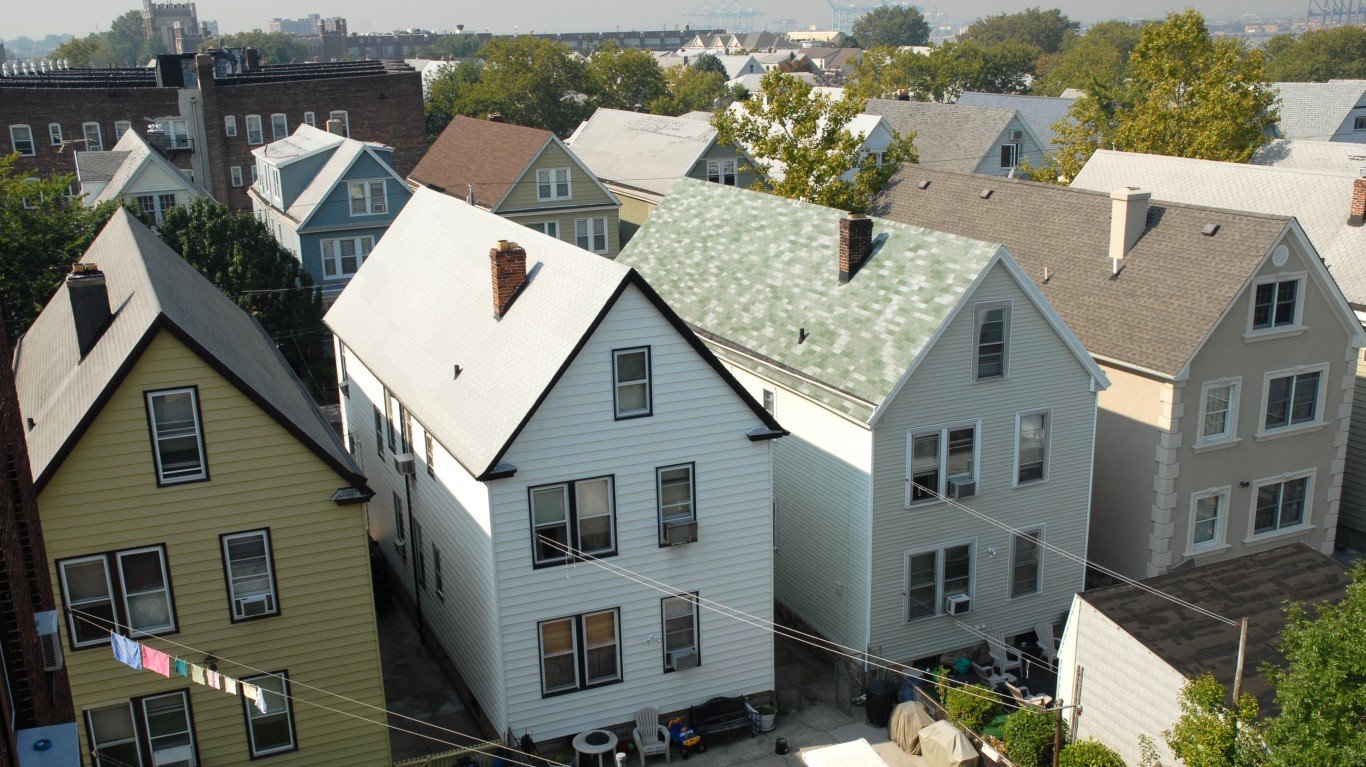
13. Essex County, New Jersey
> Population: 795,908
> Median household income: $57,365
> Households earning less than $10,000: 9.1%
> Households earning $200,000 or more: 10.8%
Essex is a densely populated county in northern New Jersey just west of Manhattan — another region on this list. Over 9% of households in Essex County earn less than $10,000, a year and nearly 11% earn $200,000 or more.
The income gap is largely driven by differences in educational attainment. The typical adult with a bachelor’s degree in Essex County earns $57,549 a year, nearly double the income of $29,233 the typical high school graduate earns.

12. Dickenson County, Virginia
> Population: 14,721
> Median household income: $29,916
> Households earning less than $10,000: 14.9%
> Households earning $200,000 or more: 1.0%
Dickenson is a small county of less than 15,000 residents in south-western Virginia. A poor county, Dickenson has median household income of less than $30,000, and about 15% of all area households earn less than $10,000 a year.
The area’s low incomes are due in large part to a relatively weak economy and a lack of high-paying jobs. As of March 2019, unemployment in the county stood at 5.4%, well above the 3.9% national unemployment rate. Even those with a college degree do not earn much more than those with just a high school diploma in Dickenson County. The typical college graduate in the county earns only about $35,000 a year, slightly less than $10,000 more than the median income of high school graduates. Nationwide, the typical adult with a bachelor’s degree earns over $22,000 more than the typical adult with just a high school diploma.
[in-text-ad-2]
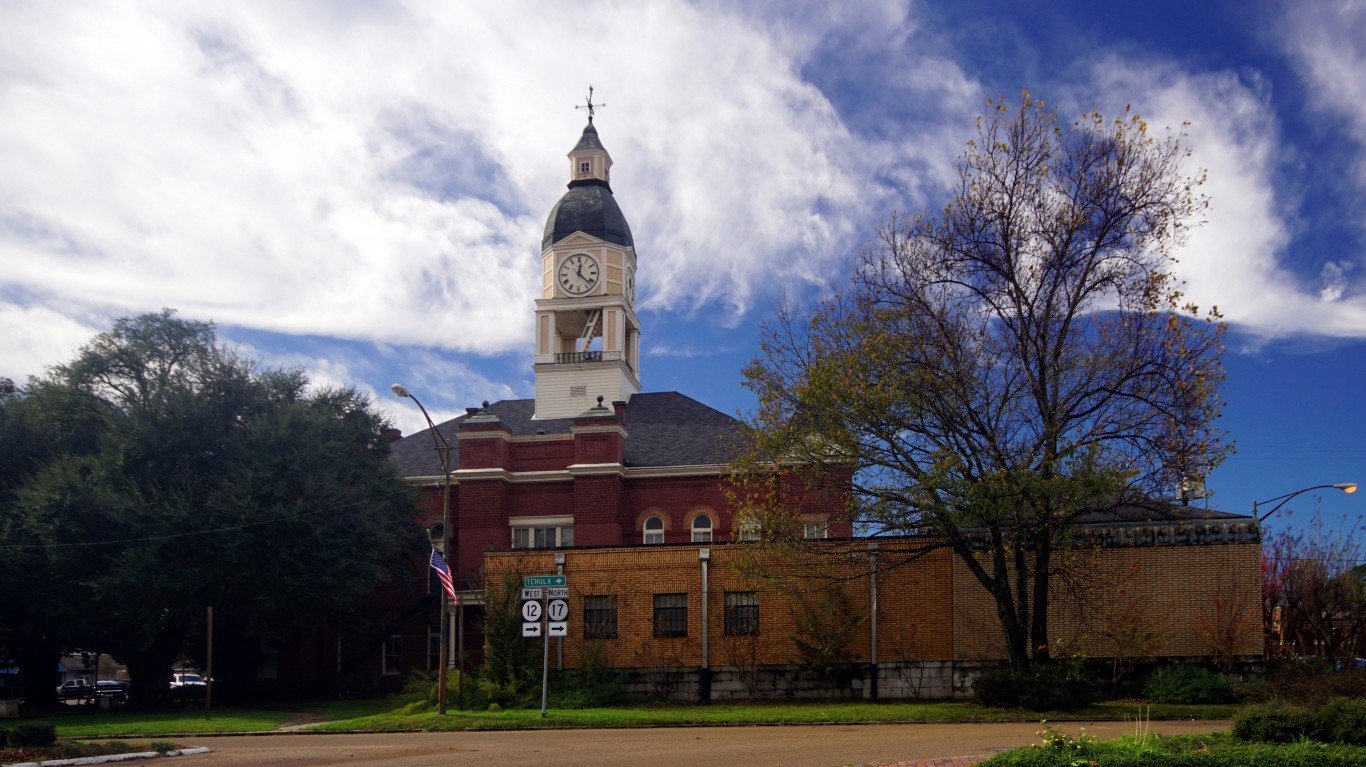
11. Holmes County, Mississippi
> Population: 17,849
> Median household income: $20,330
> Households earning less than $10,000: 29.2%
> Households earning $200,000 or more: 0.7%
Holmes County is partially located in the Delta region of central Mississippi. Like many counties on this list, the Mississippi county has a high degree of income inequality largely because of the high concentration of residents facing serious financial hardship rather than a pocket of extremely wealthy households. Over 45% of Holmes County residents live below the poverty line, and nearly 30% of area households earn less than $10,000 a year. The area’s low incomes are due in part to low educational attainment. About 25% of county adults have not completed high school, and the median annual income among them is just $17,143. Due in large part to widespread financial insecurity, Holmes ranks among the worst counties to live in.

10. Monroe County, Alabama
> Population: 21,302
> Median household income: $26,036
> Households earning less than $10,000: 24.3%
> Households earning $200,000 or more: 1.3%
Monroe is a poor county in one of America’s poorest states. Just over one in every three Monroe County residents live in poverty, well above Alabama’s 18.0% poverty rate, which is itself the sixth highest among states. While about half of all Monroe County households earn at least $26,000 a year, nearly one in every four area households earn less than $10,000 annually. This widespread financial disparity is partially attributable to a weak job market. As of March 2019, 5.9% of workers in the county were unemployed, well above the 3.9% national unemployment rate.
[in-text-ad]

9. Chicot County, Arkansas
> Population: 10,639
> Median household income: $32,412
> Households earning less than $10,000: 19.2%
> Households earning $200,000 or more: 2.2%
Chicot is a small county of less than 11,000 residents in southeastern Arkansas along the Mississippi River. About 2.2% of area households earn $200,000 or more per year, while a staggering 19.2% of households live on less than $10,000 every year. Nearly 30% of county residents live in poverty, more than double the 14.6% national poverty rate.
Arkansas is one of 41 places raising the minimum wage in 2019. Whether or not the higher minimum wage will reduce poverty and improve income gap in Chicot County remains to be seen.
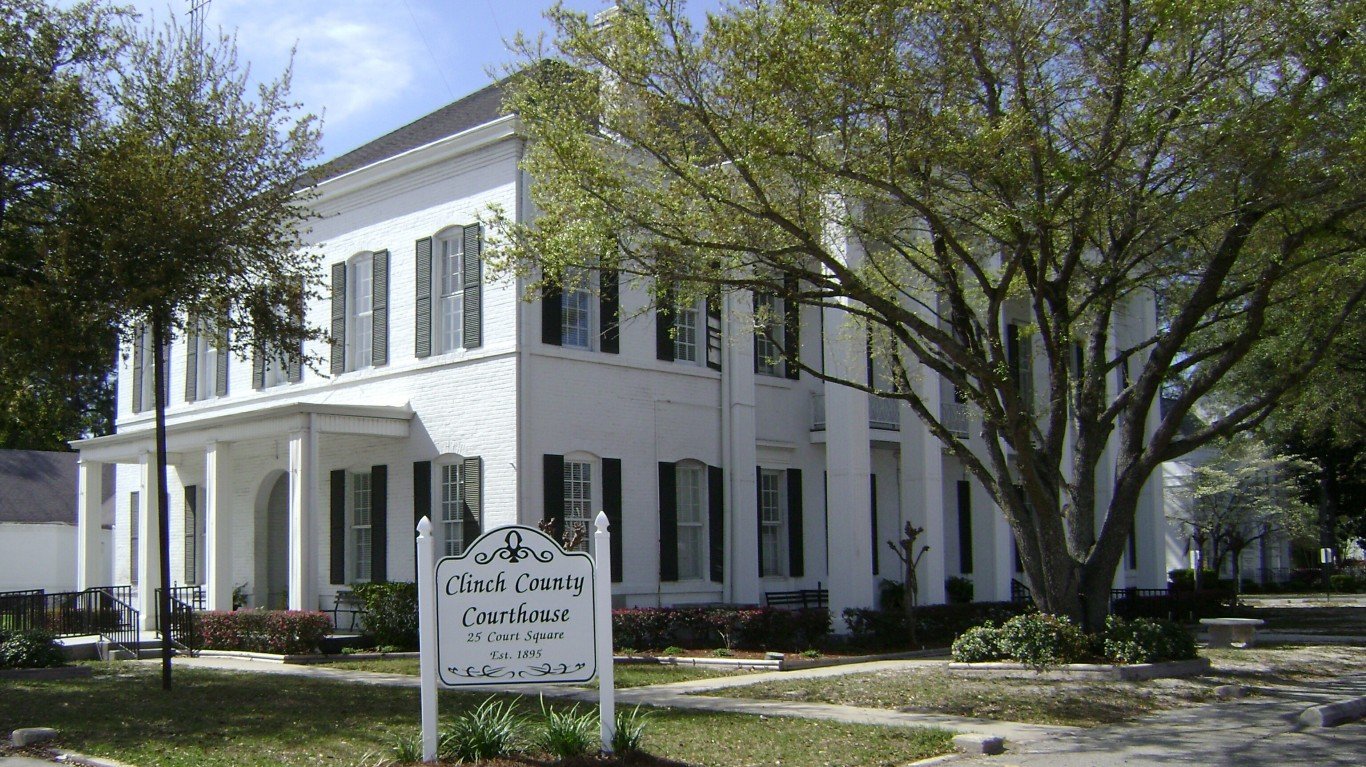
8. Clinch County, Georgia
> Population: 6,684
> Median household income: $21,838
> Households earning less than $10,000: 24.8%
> Households earning $200,000 or more: 1.2%
Clinch, located in southern Georgia along the Florida state border, is one of four counties in the state to rank on this list. About one in every four households in the county live on less than $10,000 a year, while 1.2% of area households earn at least $200,000 a year.
While a small share of area households are wealthy, a staggering 39.5% of county residents live below the poverty line. Incomes tend to rise with educational attainment, and in Clinch County, over 25% of adults never completed high school. The median annual wage for those without a high school diploma in the county is just $17,342.
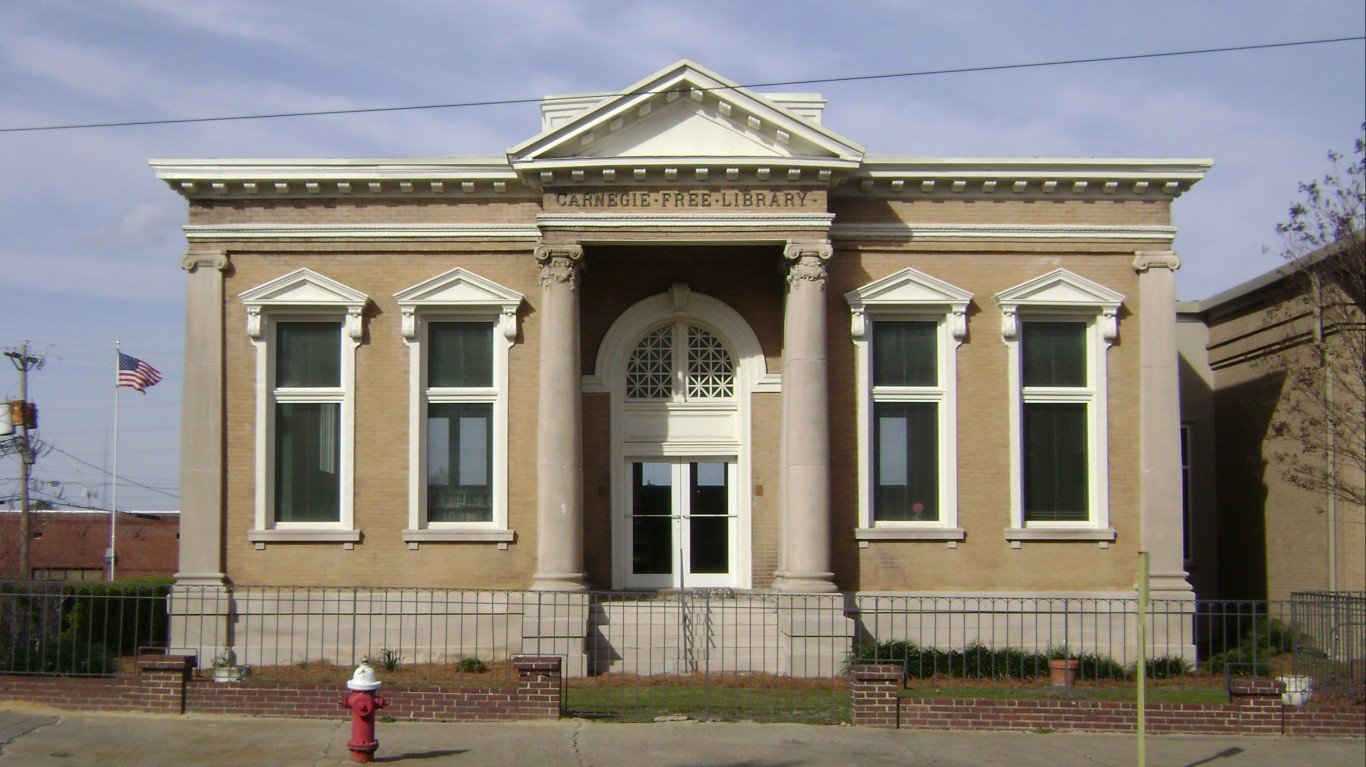
7. Crisp County, Georgia
> Population: 22,723
> Median household income: $33,194
> Households earning less than $10,000: 15.0%
> Households earning $200,000 or more: 2.6%
An estimated 2.6% of households in Crisp County earn at least $200,000 a year. At the same time, about 28.1% of the county population relies on SNAP benefits to afford groceries. The county’s stark income divide falls largely along the lines of educational attainment. The typical college-educated adult in Crisp County earns $40,638 a year, while the typical high school dropout in the county earns just $13,007 a year.
[in-text-ad-2]

6. Walthall County, Mississippi
> Population: 14,523
> Median household income: $31,077
> Households earning less than $10,000: 20.0%
> Households earning $200,000 or more: 1.7%
Walthall County is located in southern Mississippi along the Louisiana state border. One in every five county households earns less than $10,000 a year, one of the largest such shares of any county in the United States. Meanwhile, half of all households in the county earn at least $31,000 a year, and 1.7% of households earn $200,000 or more.
Mississippi has one of the worst-rated school systems of any state, and nearly one in every five adults in Walthall County have not completed high school. Of the adults without a high school diploma in the county, 45.2% live below the poverty line.

5. Orleans Parish, Louisiana
> Population: 391,538
> Median household income: $38,721
> Households earning less than $10,000: 14.8%
> Households earning $200,000 or more: 5.5%
Orleans Parish is a densely-populated area that is coterminous with the city of New Orleans. Both extreme wealth and extreme poverty are more heavily concentrated in Orleans Parish than they are across the state as a whole. About 5.5% of New Orleans households earn at least $200,000 a year, compared to 4.0% of households in Louisiana. Meanwhile, 14.8% of area households earn less than $10,000 a year compared to 10.0% of households across the state.
The large share of low-income residents face the additional financial burden of a high cost of living. The broader New Orleans metro area ranks as the most expensive city in the state.
[in-text-ad]

4. Greene County, Georgia
> Population: 17,220
> Median household income: $45,069
> Households earning less than $10,000: 11.0%
> Households earning $200,000 or more: 6.9%
Greene County, Georgia, located about halfway between Atlanta and Augsta, has the worst income inequality in the state and fourth worst of any county nationwide. Nearly 7% of area households earn at least $200,000 a year, while 11% of area households earn less than $10,000 annually — compared to 6.3% and 6.7% of households nationwide, respectively.
The county’s stark income divide falls largely along the lines of educational attainment. The typical college-educated adult in Greene County earns $61,667 a year, while the typical high school dropout in the county earns just $15,916 a year.

3. Pitkin County, Colorado
> Population: 17,952
> Median household income: $67,755
> Households earning less than $10,000: 5.4%
> Households earning $200,000 or more: 11.5%
Located in the Colorado Rockies, Pitkin County encompases several posh ski resort towns, including Aspen and Snowmass. As such, it is a desirable destination for wealthier Americans. An estimated 11.5% of households in Pitkin County earn at least $200,000 a year. The concentration of wealth in the area has driven up real estate values, and as a result, Pitkin County has the most expensive housing market in Colorado.
Resort towns typically operate on the backs of relatively low-wage service workers, and in Pitkin County, 5.4% of households earn less than $10,000 a year.

2. Lafayette County, Arkansas
> Population: 6,822
> Median household income: $32,500
> Households earning less than $10,000: 17.3%
> Households earning $200,000 or more: 2.9%
Lafayette, a small county of less than 7,000 residents in southern Arkansas along the Louisiana state border, is one of the poorest counties in the United States. An estimated 17.3% of county households earn less than $10,000 a year, well more than double the 6.7% share of households nationwide. Despite the prevalence of financial hardship, 2.9% of households in the county earn at least $200,000 a year.
Incomes tend to rise with educational attainment, and nearly 20% of adults in Lafayette County have not graduated from high school — likely in part because Arkansas has one of the lower ranked public school systems in the country. High school graduates earn a median income of $25,000 a year in Lafayette County, nearly $10,000 more than those without a diploma.
[in-text-ad-2]

1. New York County, New York
> Population: 1,629,780
> Median household income: $79,781
> Households earning less than $10,000: 8.7%
> Households earning $200,000 or more: 20.1%
Nowhere is income inequality more pronounced in the United States than in New York County, coterminous with the New York City borough of Manhattan. More than one in five area households earn at least $200,000 a year, more than triple the 6.3% of households earning as much nationwide. At the same time, 8.7% of Manhattan households earn less than $10,000 a year, more than the 6.7% national share.
The broader New York City metro area, of which New York County is the epicenter, ranks both among the American cities hit hardest by extreme poverty and America’s richest cities.
Methodology
To determine the counties with the widest income gaps, 24/7 Wall St. reviewed the Gini coefficient — a measure that denotes income inequality — for 3,142 counties and county equivalents in the United States. County equivalents include Parishes in Louisiana and independent cities in Virginia. We only considered counties and county equivalents with a Gini coefficient margin of error of less than 15%. Data came from the U.S. Census Bureau’s American Community Survey and are five-year averages for the period between 2013 and 2017. Supplementary data on population, poverty, occupation, median household income, the share of households earning less than $10,000 a year, the share of households earning $200,000 or more a year, and the share of households receiving food stamps/SNAP benefits are also five-year averages from the ACS. Unemployment rates came from the Bureau of Labor Statistics and are not seasonally adjusted estimates for March 2019.
Take This Retirement Quiz To Get Matched With A Financial Advisor (Sponsored)
Take the quiz below to get matched with a financial advisor today.
Each advisor has been vetted by SmartAsset and is held to a fiduciary standard to act in your best interests.
Here’s how it works:
1. Answer SmartAsset advisor match quiz
2. Review your pre-screened matches at your leisure. Check out the
advisors’ profiles.
3. Speak with advisors at no cost to you. Have an introductory call on the phone or introduction in person and choose whom to work with in the future
Take the retirement quiz right here.
Thank you for reading! Have some feedback for us?
Contact the 24/7 Wall St. editorial team.
 24/7 Wall St.
24/7 Wall St. 24/7 Wall St.
24/7 Wall St.
